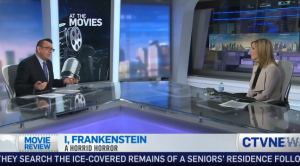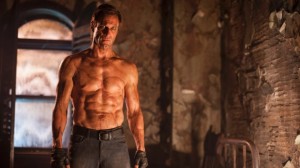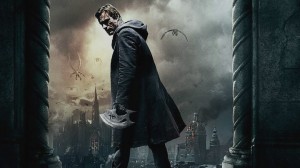Canada AM: RICHARD’S NAUGHTY AND NICE LIST: THE BEST & WORST MOVIES OF 2014
 Richard and “Canada AM” host Marci Ien have a look at the Best and Worst movies of 2014. Watch the whole thing HERE!
Richard and “Canada AM” host Marci Ien have a look at the Best and Worst movies of 2014. Watch the whole thing HERE!
 Richard and “Canada AM” host Marci Ien have a look at the Best and Worst movies of 2014. Watch the whole thing HERE!
Richard and “Canada AM” host Marci Ien have a look at the Best and Worst movies of 2014. Watch the whole thing HERE!
 NAUGHTY LIST (in alphabetical order)::
NAUGHTY LIST (in alphabetical order)::
1.) Before I Go To Sleep: “Before I Go to Sleep,” the new Nicole Kidman movie, has a lot in common with the recent hit “Gone Girl.” Both star Academy Award winners, each feature a tall icy blonde actress in the lead role and are martial stories with an edge. The big difference between them? ”Gone Girl” is a hair-raising thriller and “Before I Go To Sleep” is not.
Based on the best-selling novel by S.J. Watson, it’s the story of Christine (Nicole Kidman), a traumatized woman who wakes up everyday with no memory. As she sleeps her mind erases itself, wiping away any new information. Her husband Ben (Colin Firth) has arranged their house as a tribute to their relationship—wedding pictures and mementoes from their life together decorate the walls—to help give her a sense of time, place and security. A neuropsychologist (Mark Strong) is secretly working with her to reassemble the shards of her memory, but as her synapsis start firing she begins to question everything about her life.
It’s the stuff of a solid thriller. “Memento,” “The Bourne Identity” and “Spellbound” have all masterfully mined similar material with more success. Director Rowan Joffe has made a stylish looking movie but allows it to get bogged down by repetition and too-tame performances. It’s a shame because the twist—and you know there has to be a twist—works well enough and there are a few tense moments in the climax but the preposterous denouement wipes away any good will the film’s exciting-ish apogee offered.
2.) I, Frankenstein: An unholy mix of religion, martial arts (Adam has some slick Bruce Lee moves) and Mary Shelley, “I, Frankenstein” should have been called “Aye, yi, yi, Frankenstein.”
There is some cool gothic Gargoyle imagery on display and a variety of posh English accents to class to the joint, but it seems only Nighy realizes that this would have played better as a campy comedy.
In amongst the over earing narration, dropped storylines—for instance, a bride for Adam is mentioned and then never mentioned again—and shots of Adam peering around corners, every now and again someone will say, “I think your boss is a demon prince.”
Mel Brooks would have known how to stage that line. For all its atmosphere—i.e.: darkly shot scenes—“I, Frankenstein” would have been a lot more fun if it embraced its silly side just as Adam must embrace his humanity. With humanity comes a sense of humor, right? Not in this case. The movie plays like a satire of bad horror movies that forgot it was a satire.
3.) Left Behind: “Left Behind” stars Nicolas Cage and sets much of the action on board a plane, but make no mistake, this isn’t “Con Air.” Instead of raising hell, Cage is playing it pious in a remake of a Kirk Cameron movie about the rapture.
Based on a popular book series about the rapture by Tim LaHaye and Jerry B. Jenkins, “Left Behind” is a mainstream reboot of a successful string of Christian movies. Directed by Vic Armstrong, the legendary stunt man best known for the “Indiana Jones” movies, the new “Left Behind” has a distinct b-movie feel, with flimsy sets and bad dialogue (“Either I’m going crazy or the whole world is insane!”) but it does feature something rather remarkable—a subdued performance from Cage. Lately he’s been a practitioner of something he calls Nouveau Shamanic school of acting but here he has dialed it way down perhaps out of respect to the religious nature of the material, or perhaps he’s saving the wild stuff for “Con Air 2: This Time it’s Biblical.”
4.) The Nut Job: “The Nut Job” is an original story that feels Frankensteined together from other, better kid’s movies. Echoes of “Ice Age” style slapstick and “Ratatouille” situations and even “Animal Farm” ethos reverberate throughout. I’ll give the filmmakers credit for adding in the gangster twist and some jazzy music but it’s the characters themselves that really disappoint.
To give you an idea of the amount of thought put into the characters, let’s start with their names. Neeson’s raccoon character is inventively named Raccoon, the rat sidekick is Buddy (Robert Tinkler) and the surly squirrel is, of course, called Surly.
Different names wouldn’t have made this a better movie, but the literal names display a lack of inventiveness that permeates the entire film. The animation is fine, but the rest—the story, the voice work, the action—feels as uninspired as peanut butter without jam.
There is very little joy, almond or otherwise, in “The Nut Job.”
5.) Night at the Museum: Secret of the Tomb: Unless the movie is called “Planet of the Apes” its faint praise to say the monkey is the best thing about a picture. Such is the case with “Night at the Museum: Secret of the Tomb,” the third outing in the popular Ben Stiller kid’s franchise. Crystal the Monkey as Dexter a Capuchin monkey, gets the most laughs and is the only member of the top-of-the-line cast who doesn’t feel like they’re only in it for the big holiday movie paycheque.
“Night at the Museum: Secret of the Tomb” beats the original premise into submission, blowing up the idea of a secret nightlife at the museum into the best example this year of how franchise filmmaking can go horribly wrong. Like the dimming tablet that slows down the wax exhibits, this movie sucks the life out of once interesting characters, placing them in a plot that is essentially an excuse to showcase more characters (like Dan Stevens as Sir Lancelot and a surprising and rather charming cameo from a very big star) and bigger special effects than in parts one and two.
6.) Sex Tape: Any movie with the word sex in the title and Cameron Diaz in her underwear and a newly slim Jason Segel in the all-together should be a lot sexier than “Sex Tape” is. The first twenty minutes plays more like an attempt to break the world record for using the word “sex” in a movie than an actual story. They talk about sex, have sex, then talk about it some more, but rather than being racy or slap-your-thigh funny it becomes tiresome. The only word used more often is “iPad,” which is even less provocative.
At one point in the film Diaz talks about her love of porn, but adds she doesn’t watch it anymore because, “the quality of the writing has gone down hill. I like it when they really feel like they’re in love.” She might have been talking about her own movie.
7.) Sin City: A Dame to Kill For: “Sin City” A Dame to Kill For” feels like it was made by someone with an eye for the aesthetics of noir but the interests of a 14-year-old boy. It’s an exercise in style over substance that will make your corneas tingle, tickle your prurient side and provide an experience that may be memorable (especially if you are a fourteen year boy) but not particularly rewarding.
These unendingly grim crime stories aren’t so much hard-boiled as they are over-baked. Rodrigues and Miller’s outlook is as bleak as the stark black-and-white palette they use to illustrate the movie. “Death is just like life in Sin City,” they say, hammering the point home that the only relief from the ennui many of these characters live with is a bullet to the head. The characters seem to welcome it. “He’ll eat you alive,” a bartender tells Johnny about the senator. “I’m a tough chew,” he replies, playing chicken with his life.
The directors try to distract from the cynical goings on with hyper-German Expressionist cinematography and Eva Green’s wardrobe, or lack thereof, but no matter how much style or skin are exposed, “Sin City: A Dame to Kill For” remains a slickly styled exercise in pointlessness.
8.) Tammy: The last time Susan Sarandon went on a cinematic road trip she was teamed with Geena Davis in a film that reinvented the buddy picture and earned praise from critics who called it a “neo-feminist road movie.”
This time out the Sarandon shares the front seat with Melissa McCarthy. Where “Thelma & Louise” learned about loyalty and sisterhood, Tammy and Pearl only pick up tips about drinking and driving, how to rob restaurants and how to destroy a jet ski.
Road movies are episodic by nature. Their stories move from place to place, from character to character, all bound by a theme. Unfortunately “Tammy” simply moves slowly from scene to scene, content to rely on McCarthy’s comedic appeal at the sacrifice of anything more than pratfalls and awkward humor.
In other words “Tammy” earns a laugh or two when McCarthy falls down, less so when she is standing upright, which is most of the movie.
9.) Transcendence: “Transcendence” asks some interesting questions. Can technology provide some sort of life after death? Does artificial intelligence offer more promise or peril? How much humanity can a computer program possess? Is “Her” a better movie about love in the computer age?
The questions are interesting and might have been thought provoking if “Transcendence” was a better movie. Director Wally Pfister (best known as Christopher Nolan’s DOP of choice) and screenwriter Jack Paglen tackle big questions head on, but in the most perplexing of ways. Weird tonal shifts from sci fi to cyber love to techno terrorism make for a drearily paced film. Add to that unclear character motivations—MILD SPOILER ALERT: exactly who’s side is Max on?—and an underdeveloped love story and you’re left with a film that brims with promise but underwhelms.
So too does Johnny Depp. You have to cut him some slack because for 90% of the film he only appears on computer screens, doing his best HAL impression, but he seems to have checked out long before his character does. Hall and Bettany do some soulful work, but are hampered by a love story that is more about code than contact.
“Transcendence” has style, and it should, Pfister (who used DOP Jess Hall on this film) is a gifted shooter who gave us one of my favorite shots of recent years—The Joker hanging out of the cop car in “The Dark Knight,” surrounded by blurred lights and city scape. Given the choice I’d choose to watch that thirty seconds again and again over spending one more minute in the lackluster world of “Transcendence.”
10.) Winter’s Tale: What is meant to be an uplifting experience about the power of love and the triumph of good over evil felt more like being strapped to a chair and force-fed all nine seasons of “Touched by an Angel.”
Based on the best-selling novel of the same name by Mark Helprin and brought to the screen by Oscar winning writer-turned-director Akiva Goldsman the story begins when Peter Lake (Colin Farrell), a turn-of-the-last century burglar, comes across the love of his life while robbing a mansion he thought was empty.
Beverly Penn (Downton Abbey’s Jessica Brown Findlay) the beautiful-but-doomed daughter of a wealthy newspaper tycoon, is a precocious and philosophical young woman with just months to live. He wants to save her, but first he must save himself from demonic crime lord Pearly Soames (Russell Crowe), a brutal man who wants Lake dead. Then, in a twist suggested by the Brothers Grimm, he finds himself thrust one hundred years into the future with only the faded memory of Beverly and a white guardian angel horse as company.
As silly as the movie is, and make no mistake, this is what I like to call an S.D.M.—Silly Damn Movie—Farrell and Findlay manage to bring the romantic side of the tale alive. Their first meeting, over a cup of tea, is simple, effective and bristles with sexual tension. The love story, although a bit starry-eyed, works until the magic realism takes over and the story becomes loopier and loopier. By the time the words, “Is it possible to love someone so much they can’t die?” spill from Farrell’s lips all is lost, and that’s not even an hour into the story.
Putting aside the enchanted horses and dime store spirituality for a moment, the story often requires leaps of faith that would have even terrified Evel Knievel. This is the kind of movie where mothers willingly hand over their sick children to scruffy looking strangers on the promise of a miracle. It’s the kind of movie where people accept outlandish events with a tossed off phrase like, “How’s that even possible?” It’s the kind of sloppily plotted movie that involves a level of suspension of disbelieve so off-the-charts it’s almost in outer space.
 Film critic Richard Crouse reviews ‘Devil’s Knot’, ‘Whitewash’, ‘I, Frankenstein’, and ‘Blue Jasmine’ with CTV News Channel’s Marcia McMillan. Tune in every Friday afternoon at 2:50 pm to see Richard and Marcia chat movies!
Film critic Richard Crouse reviews ‘Devil’s Knot’, ‘Whitewash’, ‘I, Frankenstein’, and ‘Blue Jasmine’ with CTV News Channel’s Marcia McMillan. Tune in every Friday afternoon at 2:50 pm to see Richard and Marcia chat movies!
Watch this whole clip HERE!
 Reel Guys By Richard Crouse and Mark Breslin – Metro Canada
Reel Guys By Richard Crouse and Mark Breslin – Metro Canada
SYNOPSIS: I, Frankenstein, Aaron Eckhart’s martial arts update of the famous Mary Shelley story wasn’t screened for the press in time to meet our deadline, so after a long conversation with our editor the Reel Guys have decided to do a column on Eckhart’s oeuvre. At least that’s how we saw it. Our boss has a different idea. “As your editor I demand a thorough dissection of Eckhart’s abs,” she wrote before adding, “More than pretty, Eckhart is.” What follows is our humble attempt to mix cinematic business with our editor’s pleasure.
RC: Mark, Aaron Eckhart isn’t exactly a household name, but he has appeared in some very big movies. He’s the only live-action actor in the Batman films to play both Harvey Dent and his villainous alter-ego Two-Face. The Dark Knight is by far and away his biggest hit, followed by his star-making turn in Erin Brockovich but despite those box office busters we don’t talk about the handsome actor in the same breath as a-listers like Cruise, di Caprio or Smith. He has the above- mentioned absn and is versatile to star in everything from video game action movies like Battle: Los Angeles to hardcore dramas like Rabbit Hole and yet doesn’t get the same recognition as many of his peers. What’s your take on him?
Mark: You mean the cleft that walked like a man? I could probably fit my grad thesis in there! Eckhart exploded onto my radar with two films he did in the late Nineties, both by the cynical playwright Neil Labute: In the Company Men, and Your Friends and Neighbors. In both films he plays despicable, curdled, almost unwatchably misogynistic men. The key word here is almost. As rotten as he behaves in these movies, there’s an inchoate grace under the surface that redeems the characters, and it’s a testimony to his acting skills that he can keep us watching. And that cleft.
RC: Some like the cleft, some the abs. I like his versatility. In a year span between 2010 and ’11 he released three very different movies. In Rabbit Hole and Nicole Kidman were a couple trying to deal with the death of their four-year-old son. They are at different stages of their grief, but they share a couple of things; a terrible sense of loss and an inability to know how to deal with it. Terrific stuff. Next was the alien invader movie Battle Los Angeles followed by The Rum Diaries where he played a slick PR person. Three different movies and three very different performances. Maybe we have a hard time defining him because he constantly does wild career flip flops.
MB: Or because there’s an opacity to him that allows him to play so many compromised characters, allowing us to project our feelings onto him. Look at one of his finest roles, as the tobacco lobbyist in Thank You For Smoking. He’s so slick, so shifty, we don’t judge him, precisely because we don’t really know him. A quality that’s great for an actor. but less so for a movie star. I really liked him in Rabbit Hole and Rum Diaries, too, but his mainstream work doesn’t register with me as much. Except for his cleft.
RC: He’s has made a number of movies I wouldn’t recommend for the big screen but work well enough as rentals. Two action films, Erased and Suspect Zero are very VOD friendly and feature many cleft hero shots.
MB: Or two romantic comedies that would have been disastrous without him: No Reservations and Love Happens. He doesn’t do nude scenes in them, though, because in close-up you couldn’t tell if it were his backside or his cleft.
 Two hundred years after Henry Frankenstein strung “a dozen used parts from eight different corpses” together and brought them to life with a bolt of electricity and the cry of, “Look! It’s moving. It’s alive. It’s alive…” the creature is back for a new adventure based on the graphic novel called “I, Frankenstein” by Kevin Grevioux.
Two hundred years after Henry Frankenstein strung “a dozen used parts from eight different corpses” together and brought them to life with a bolt of electricity and the cry of, “Look! It’s moving. It’s alive. It’s alive…” the creature is back for a new adventure based on the graphic novel called “I, Frankenstein” by Kevin Grevioux.
This time around his green parlor and neck bolts are gone, replaced by a chin cleft Igor could hide in and scars lining his unusually fit body. He’s a tormented soul, or rather, it is his lack of a soul that torments him. “I care not for the world of men,” he says, “I go my own way.”
For hundreds of years instead of terrifying villagers Dr. Frankenstein’s creature, now dubbed Adam (Aaron Eckhart) has hidden himself in the most remote places where he thought no human, demon or Gargoyle could find him. But he was wrong.
It seems a legion of 666 fiends, led by a demon prince named Naberius (Bill Nighy) are desperate to find Adam so they can learn the secret of reanimating corpses. Naberius plans on inserting demon souls into dead bodies to create an unstoppable army and “unravel the mortal coil of life.”
On the other side are the Gargoyles, commanded by Leonore (Miranda Otto), an archangel determined to help Adam find his humanity and save the human race.
An unholy mix of religion, martial arts (Adam has some slick Bruce Lee moves) and Mary Shelley, “I, Frankenstein” should have been called “Aye, yi, yi, Frankenstein.”
There is some cool gothic Gargoyle imagery on display and a variety of posh English accents to class to the joint, but it seems only Nighy realizes that this would have played better as a campy comedy.
In amongst the over earing narration, dropped storylines—for instance, a bride for Adam is mentioned and then never mentioned again—and shots of Adam peering around corners, every now and again someone will say, “I think your boss is a demon prince.”
Mel Brooks would have known how to stage that line. For all its atmosphere—i.e.: darkly shot scenes—“I, Frankenstein” would have been a lot more fun if it embraced its silly side just as Adam must embrace his humanity. With humanity comes a sense of humor, right? Not in this case. The movie plays like a satire of bad horror movies that forgot it was a satire.
 By Richard Crouse – In Focus Metro Canada
By Richard Crouse – In Focus Metro Canada
The eight-foot-tall, gruesomely ugly creation of Victor Frankenstein has been called many things. In the original Mary Shelley novel he is named The Ogre. In the credits of the Boris Karloff film he is referred to as The Monster. He’s also been called a fiend, the thing and the demon.
All those terms are apt for a creature born of dead body parts but a new movie adds a different name to the list—Adam. As in Adam Frankenstein.
I, Frankenstein, stars Aaron Eckhart as Adam, the prefab man. He’s now an immortal martial arts expert battling a war between rival clans in an ancient city. The character takes the name from the Shelley book. Sort of.
Shelley never gave the monster a name—people often mistakenly refer to him as Frankenstein—but in the novel the creature says to Victor, “I ought to be thy Adam; but I am rather the fallen angel.”
Whatever you want to call him, Frankenstein’s Monster has always been a popular character in the movies.
The most famous film featuring the creature has to be Boris Karloff’s 1931 classic, but it wasn’t the first. Five silent films, one with the dramatic title Life Without Soul and another that featured the brute emerging from a cauldron of fiery chemicals, all played to packed houses.
From those dramatic beginnings dozens of movies followed.
Robert De Niro played the beast in Mary Shelley’s Frankenstein. On the set director Kenneth Branagh banned the word “monster,” insisting instead that everyone refer to the creature the same way he is billed in the credits, as “The Sharp Featured Man.”
Frankenstein: The College Years is basically an unlikely mix of Shelley’s story and Encino Man. Directed by Tom Ace Ventura: Pet Detective Shadyac, this 1991 comedy sees college student Mark (William Ragsdale) reanimate Dr. Frankenstein’s creature who then becomes a football star and a big man on campus known as Frank N. Stein (Vincent Hammond). “He blends right in,” says Mark of the six-foot-nine Frank, “he’s a regular invisible man.”
The movie The Bride, a 1985 remake of The Bride of Frankenstein starring Sting and Jennifer Beals, gave the fiend yet another name. He was dubbed Viktor but not in tribute to his creator Victor Frankenstein. In this retelling the good doctor is known as Baron Charles Frankenstein. The name Viktor was chosen in tribute to the film’s producer Victor Drai.